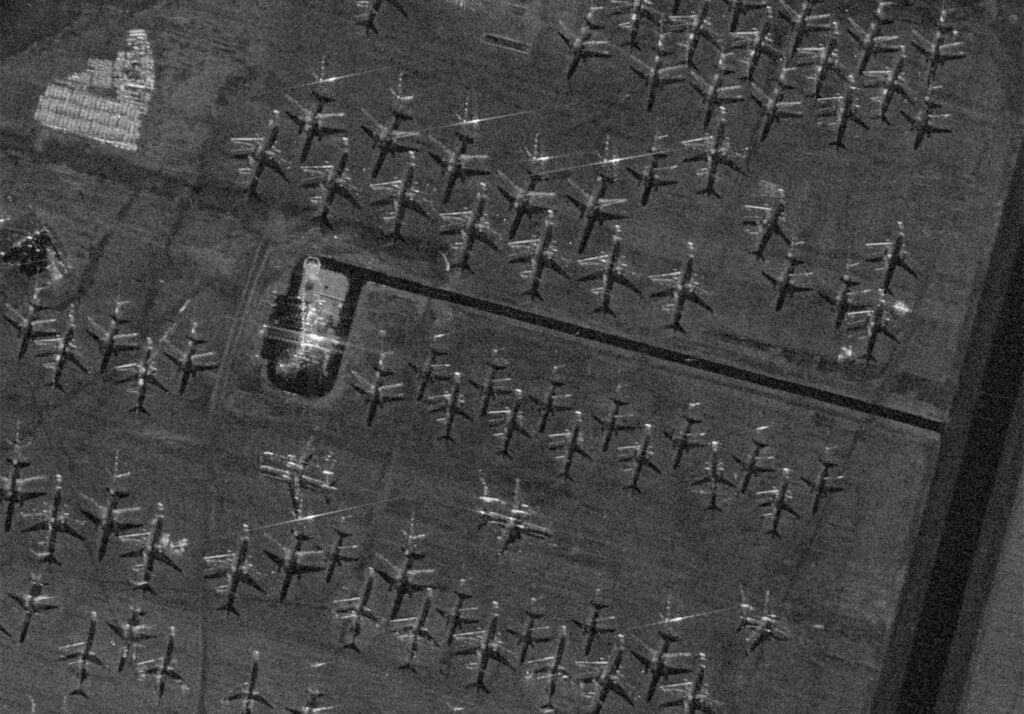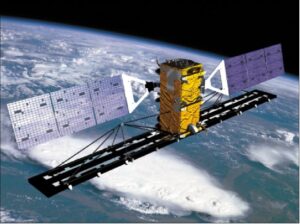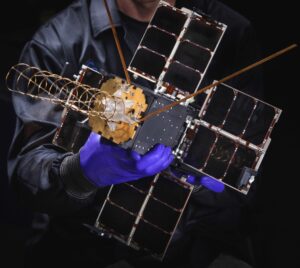
American Airlines retires its McDonnell Douglas MD-80 aircraft and Airbus A300-600R jetliners at the Roswell Air Center in New Mexico. Capella’s highest resolution imaging mode shows the aircraft and their shadows reveal granular details such as the size of a cockpit, fuselage, wings and engines. (Capella)
WASHINGTON: In recent months, commercial remote sensing company representatives have become increasingly jaded with long-standing promises by the National Reconnaissance Office to increase its acquisition from, and support of, the burgeoning industry.
Many in industry had their hopes raised in the waning years of the Trump administration, and more recently by strong congressional pressure on the agency to take commercial providers seriously. More were cheered earlier this month at the annual GEOINT Symposium, when Deputy Director of National Intelligence Stacey Dixon reiterated the robust support of the Intelligence Community, as well as the Biden White House, for this capability.
But behind all the smiles and promises, a number of industry officials tell Breaking Defense, the facts on the ground tell a different story.
For example, industry officials are pushing back against the NRO’s move, first revealed by Breaking Defense, to impose a kind of “shutter control” on sales to other customers via its contracting process. Meanwhile, word on the street is that NRO’s fiscal year 2022 budget for purchasing commercial data has been slashed, along with that of the National Geospatial-Intelligence Agency (NGA), which buys analytical products from commercial remote sensing firms. (Neither IC agency will discuss its budget.)
And for that reason, at least some industry execs now say they are pivoting marketing efforts away from the NRO and instead focusing on direct sales to other US national security customers, such as the military services and Combatant Commands — and even foreign governments. This is in part because many commercial remote sensing firms, both in the US and abroad, have been funded by short-term venture capital, and waiting for substantial contracts come to fruition can be a life or death matter.
Such a shift could chip away at the relevancy of both the NRO and the NGA, which relies on NRO to provide imagery for its map making and other GEOINT products for US government customers. Indeed, former senior US intelligence official Sue Gordon earlier this month raised the question of how the IC can maintain its role “in a world that now has access to all the same data.”
In the midst of this grumbling comes a new blow to industry confidence, in the form of an Oct. 12 release of NRO’s new Broad Agency Announcement (BAA) Framework for Strategic Commercial Enhancements.
The BAA is an umbrella tool that, according to an email from NRO, covers acquisition of “new and emerging phenomenologies, such as commercial radar, hyperspectral imagery, radio frequency remote sensing, etc., as well as emerging and evolving electro-optical capabilities.” It was much touted by NRO leaders at the GEOINT Symposium earlier this month as a means to move forward more quickly than a traditional contracting pathway, developed after years of studying how commercial data best fits into the agency’s data architecture.
Along with the details of the framework (available to registered industry at NRO’s online contracting hub), NRO released a formal solicitation for bids in the first focus area, commercial SAR, open to both US and foreign-owned, US-based firms. The SAR solicitation is thus the model that NRO is using for acquisition of future “emerging phenomenologies,” with its acquisition of electro-optical imagery being kept under a more traditional contracting path.
For the SAR solicitation, “the combined stage 1 and 2 award is anticipated at $1.2 million. These awards could be made to a single provider, multiple providers, or no provider,” an NRO spokesperson confirmed in an email Thursday.
In response to a question about industry concerns and whether follow-on contracts are anticipated, the spy agency spokesperson said: “Mission requirements and needs will determine whether follow-on acquisition efforts for each of the BAA focus areas are required.”
Which, industry sources say, means that there is no way to know if a phase 3 follow-on will actually include real money, making it hard for remote sensing firms to plan how much time and effort to put toward winning NRO awards — and giving them even more incentive to abandon trying to work with the agency in favor of other customers.
Death By Study For Commercial SAR?
The tiny contract size and its duration of 30 months — the same magnitude as a typical government study contract — was a bit of a shock to industry players.
“I’d call it a VERY minor slow toe dip,” said one company rep, trying to find polite words. At the same time, the source said, “In the words of good parenting, I’m not mad, I’m just disappointed.”
For context, Phase 1 Small Business Innovation Research (SBIR) awards, used regularly by the Defense Department to bolster development of cutting-edge tech by small firms, have a range of $50,000 to $250,000 over six months. Follow-on Phase 2 contracts are generally about for $750,000 over two years.

RadarSat 2, launched in 2007. (ESA image)
“My question is, why are we studying this again,” said another frustrated industry source, noting that the capabilities of synthetic aperture radar (SAR) sat companies have been demonstrated not just directly to NRO but also in various Combatant Command and service exercises. “We, the collective we, know what SAR does,” the source said. “So, if we have data that can help inform decision-makers today, why aren’t we getting it to them?”
A perfect example comes from Thursday’s announcement from Capella Space that it has reached a new agreement with the Army to explore the use of firm’s SAR satellite imagery. According to the release, Capella not only received a contract from NRO in 2019, but also over the past year has “signed and maintained contracts with the US Navy, US Air Force, National Geospatial-Intelligence Agency, In-Q-Tel, the Space Development Agency, and the US Space Force to provide on-demand, high-resolution SAR data and analytics.” (Although to be fair, other industry sources note, those contracts are small.)
Capella also took “gold’ for best SAR image resolution in the NGA’s recent “Remote Sensing Olympics” comparing global capabilities of commercial companies.
And Capella is neither the only US SAR sat firm, nor the world’s first commercial SAR sat company looking to sell to the US government and the international market. Canadian company MDA Ltd. has the honor of being the first commercial firm to launch a SAR sat, RadarSat-2, in 2007, and has been selling SAR imagery since that time. And Umbra, another California startup, emerged from stealth mode earlier this summer, pitching itself directly at the US government market.
Finland’s ICEYE, which has a US arm, markets itself as the owner of the world’s first constellation of smallsats using SAR, with 14 birds now on orbit. The tiny company came in first in the NGA mock Olympics for highest revisit rate — that is, how often one of its satellites can return to the same ground target and take an image. The US arm of the multinational European aerospace conglomerate Airbus, Airbus U.S. Space and Defense, also is offering commercial SAR products to US government customers. Airbus is the biggest commercial SAR player in the European market.
To the NRO’s credit, said the disappointed source, part of the reason for the BAA’s small size and long duration is that the spy agency is trying to keep open possible awards to very early startups. For those companies, NRO has to do more extensive evaluation — including to ensure that new sources of data can be integrated with its own complex computer networks and top secret data. Still, the source noted, the solicitation could have been shaped into phases that would have allowed NRO to buy available imagery now, and wrap in new providers at a later time.

Gunsmoke-J experimental satellite (Army image)
Imagery Hungry Warfighters
Meanwhile, military commanders are clamoring for ever-more imagery and other types of intelligence, surveillance and reconnaissance data from satellites (such as signals intelligence) to support future All Domain Operations around the globe with Russia and China.
The Army, at the moment, is the service most involved in trying to directly get its hands on remote sensing imagery and sat-provided ISR, not just from SAR sat operators but those providing electro-optical and other types of sensors. But the Space Force also recently put its hand up, pushing to expand its current role in providing commercial communications bandwidth to include remote sensing and ISR, eyeing service contracts with providers for open, long-term access.
Meanwhile, the leaders of Combatant Commands are eyeing using their own funding pots to acquire timely remote sensing/ISR satellite data. For example, Capella was an industry participant in the recent Northern Edge 21 exercise, sponsored every other year by Indo-Pacific Command.
“And COCOMS don’t want to wait two and a half years for this data” from NRO, one industry source noted.
The Army’s new deal with Capella is a no-cost Cooperative Research and Development Agreement (CRADA) with the US Army Space and Missile Defense Technical Center (SMDTC). It will see Capella integrating SAR data into the Army’s Payload Development Lab, which is exploring SAR and “other space-based technology concepts within both simulated and test environments,” the release says.
“Capella space is excited to be working with the United States Army as we continue to expand our support to the Department of Defense as the leading US provider of commercial SAR,” Amy Hopkins, the company’s new vice president of government services, told Breaking Defense.
Army SMDTC, as its website explains, “provides technologies to meet today’s requirements and future needs in directed energy, space, cyberspace, hypersonics and integrated air and missile defense.”
Tom Webber, the SMDTC director, said in the press release: “Capella is the first U.S. company to commercialize SAR and is uniquely positioned to provide mission-critical support to tactical users and advance the Army’s critical mission.”
"direct" - Google News
October 22, 2021 at 05:16PM
https://ift.tt/3B4RSE1
EXCLUSIVE: Imagery Industry Seeking Direct DoD Sales In Wake Of Tiny NRO Bid - Breaking Defense
"direct" - Google News
https://ift.tt/2zVRL3T
https://ift.tt/2VUOqKG
Direct
Bagikan Berita Ini














0 Response to "EXCLUSIVE: Imagery Industry Seeking Direct DoD Sales In Wake Of Tiny NRO Bid - Breaking Defense"
Post a Comment